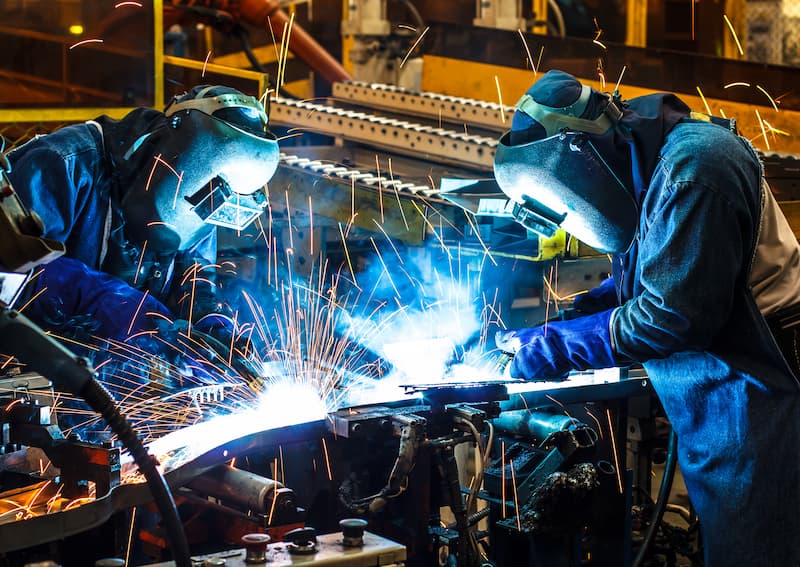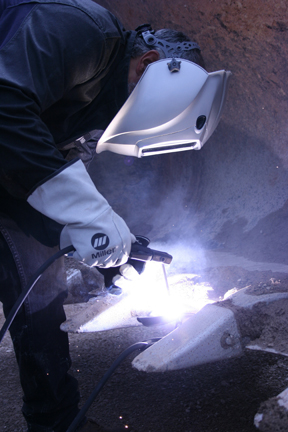All Regarding Welding: Key Insights Into Techniques and Finest Practices for Success
Welding encompasses a selection of methods, each matched for specific products and applications. Recognizing these approaches, such as GMAW, SMAW, and TIG, is crucial for attaining optimal outcomes. Furthermore, the best equipment and security practices can not be forgotten. As prep work and fixing play vital duties in the welding process, understanding these aspects can greatly improve the top quality of the end product. What are the crucial factors that guarantee a successful weld?
Comprehending Different Welding Techniques
Welding strategies incorporate a variety of methods, each matched to specific applications and materials. Among one of the most common strategies are Gas Metal Arc Welding (GMAW), Secured Metal Arc Welding (SMAW), and Tungsten Inert Gas Welding (TIG) GMAW, likewise referred to as MIG welding, is popular for its rate and flexibility, making it perfect for thin products. SMAW, or stick welding, is preferred for its simplicity and effectiveness in outside environments, particularly with thicker steels. TIG welding provides precision and control, making it suitable for intricate job and non-ferrous metals (Welding). Each technique has its special advantages and factors to consider, permitting welders to select the finest method based on the job's needs, product kind, and desired end results. Understanding these strategies is vital for successful welding
Necessary Welding Devices and Devices
While numerous welding methods require particular abilities, the right equipment and tools are just as important for accomplishing high quality results. Necessary welding devices includes welding machines, which vary depending upon the method-- such as MIG, TIG, or stick welding. Safety gear, including aprons, gloves, and safety helmets, assurances safety and security and comfort during the procedure. Additionally, components and clamps help safeguard products in area, making sure accuracy in welds. Consumables like welding poles, cord, and protecting gas are also important elements that influence the high quality of the weld. Devices such as mills and cutters facilitate surface area prep work and post-weld completing, contributing to a professional outcome. Investing in premium equipment ultimately boosts the efficiency and efficiency of welding tasks.
Safety Practices in Welding
Proper safety and security methods are crucial in the welding market to secure workers from possible risks. Welders should use appropriate individual protective tools (PPE), including headgears with proper shading, handwear covers, and flame-resistant clothing. Adequate ventilation is crucial to minimize exposure to unsafe fumes and gases generated throughout the welding process. Furthermore, workers ought to be learnt the proper handling of welding devices to stop crashes. Fire security actions, such as keeping combustible materials away from the welding location and having fire extinguishers conveniently available, are necessary. Routine evaluations of tools and work spaces can assist identify possible risks before they bring about accidents. By sticking to these safety methods, welders can produce a more secure working environment and lessen threats connected with their profession.
Preparing Products for Welding
Preparing materials for welding is an essential step that greatly influences the quality and integrity of the end product (Belgrade Welding). Correct prep work involves cleaning up the surfaces to remove contaminants such as dust, corrosion, and oil, which can endanger the weld. Techniques such as grinding, fining sand, or utilizing solvents are frequently used to attain a tidy surface. Additionally, guaranteeing that the products mesh well is essential; voids can result in weak welds. It's also essential to consider the alignment and positioning of the elements, as this will influence the simplicity of welding and the final outcome. Choosing the ideal filler product and guaranteeing compatibility with the base steels is necessary for achieving solid, durable welds.
Tips for Getting High-Quality Welds
Achieving high-grade welds needs focus to detail and adherence to finest practices throughout the welding procedure. Correct joint prep work is crucial, making sure surface areas are free and tidy from pollutants. Picking the proper filler material and welding technique based upon the base steels is important for ideal bonding. Preserving regular travel rate and angle while welding can advertise and protect against defects uniformity. In addition, managing heat input is crucial; excessive heat can cause warping and damaged joints. If essential, consistently inspecting the welds throughout the procedure permits for prompt changes. Employing proper post-weld treatments, such as cleansing and stress and anxiety relief, can boost the resilience and integrity of the weld, ultimately making certain an effective result.
Fixing Usual Welding Issues
Welding usually offers difficulties that can impact the high quality and integrity of the end product. Typical problems such as porosity, go to my blog inconsistent weld beads, and overheating can emerge, each needing details repairing methods. Recognizing these issues is crucial for welders to improve their skills and attain excellent outcomes.
Porosity Problems Discussed
Although porosity can frequently be overlooked, it remains a critical concern in welding that can compromise the stability of a finished product. Porosity describes the presence of little gas pockets within the weld grain, which can lead and deteriorate the joint to early failing. This trouble commonly arises from contaminants, moisture, or incorrect protecting gas protection during the welding procedure. To reduce porosity, welders should validate that the base materials are clean and dry, make use of appropriate protecting gases, and preserve regular welding criteria. Consistently inspecting the tools and atmosphere can likewise help determine prospective problems prior to they manifest in the weld. Dealing with porosity successfully is vital for accomplishing solid, sturdy welds that fulfill quality requirements.

Inconsistent Weld Beans
Irregular weld grains can considerably impact the quality and toughness of a finished item. Various elements add to this concern, including improper travel rate, inaccurate amperage setups, and irregular electrode angles. When the welder relocates also rapidly, a bead might show up slim and do not have penetration, while moving too slowly can cause extreme accumulation. Additionally, utilizing the incorrect amperage can lead to either undercutting or too much spatter, both of which concession weld honesty. The welder's technique, such as irregular lantern motion, can additionally result stud welder in unequal grain look. To minimize these troubles, welders must focus on maintaining constant, regulated movements and guaranteeing proper tools settings to attain uniformity in their welds. Uniformity is vital to achieving dependable and solid welds.
Overheating and Warping Issues
Extreme warm during the welding process can lead to considerable overheating and deforming problems, impacting the structural integrity of the workpiece. These troubles typically show up as distortion, which can jeopardize placement and fit-up, making more assembly testing. Variables adding to overheating consist of the selection of welding specifications, such as voltage and travel rate, in addition to the type of material being welded. To minimize these issues, welders need to keep constant travel speed and suitable warmth input while checking the work surface temperature. Additionally, pre-heating or post-weld warmth therapy can aid reduce stress and anxieties triggered by fast cooling - Montana Mobile Welding and Repair Fabrication. Normal examination and adherence to ideal methods are important in preventing getting too hot and ensuring the longevity and integrity of welded frameworks
Often Asked Questions
What Are the Career Opportunities in the Welding Market?
The welding industry offers varied profession possibilities, including positions as published here welders, examiners, engineers, and instructors. Specialists can work in production, building and construction, aerospace, and automobile fields, taking advantage of solid demand and competitive wages in different roles.
How Can I Boost My Welding Rate Without Sacrificing Top Quality?
To boost welding rate without sacrificing quality, one should practice reliable strategies, keep devices, optimize settings, and boost hand-eye sychronisation. Regular training and seeking comments can likewise greatly add to achieving quicker, premium welds.
What Certifications Are Offered for Welders?
Countless certifications exist for welders, consisting of those from the American Welding Culture (AWS), the National Facility for Building Education And Learning and Study (NCCER), and various industry-specific companies. These credentials improve employability and show skill efficiency.
Exactly How Does Welding Affect the Residences of Metals?
Welding influences the buildings of metals by changing their microstructure, which can bring about changes in ductility, hardness, and toughness. Warmth input and air conditioning prices during the process considerably affect these product attributes.
Can I Bonded Dissimilar Metals Together?
